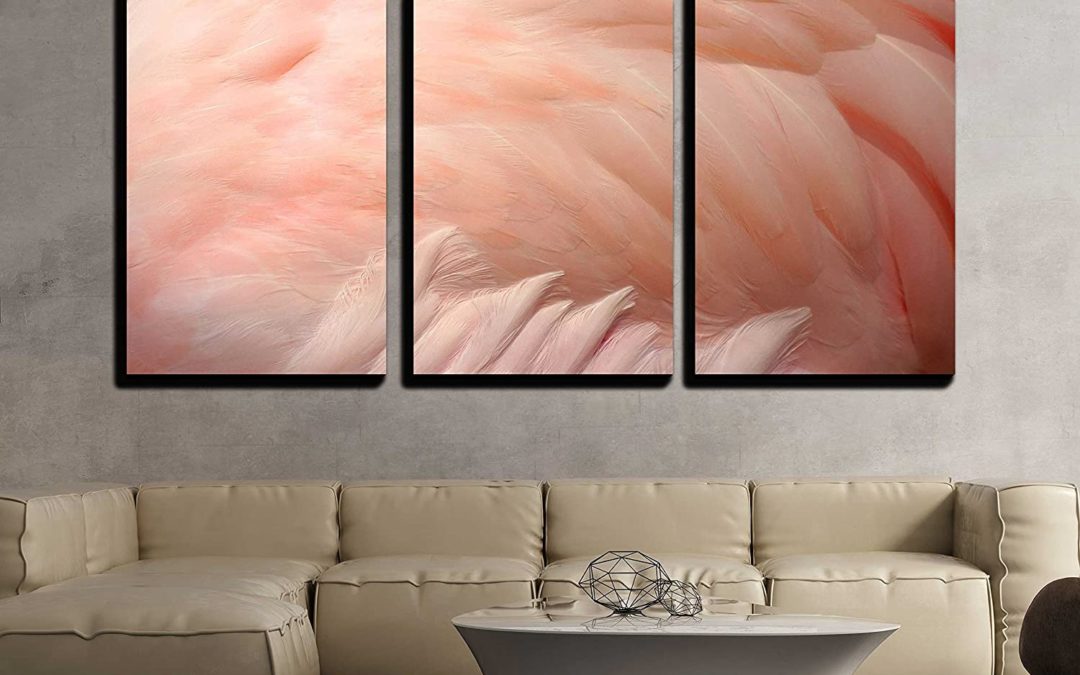Is there are more interesting looking bird than the vibrant, pink flamingo? Their signature pink feathers and odd method of standing has made flamingos one of the most instantly recognizable animals in the world. Flamingos are a type of wading bird that usually like to live in areas that feature or are composed of shallow lakes, lagoons, swamps, or sandy beaches. The word “flamingo” comes from the Spanish word “flamenco”. This word comes from the Latin word “flamma” meaning flame or fire. There are six species of flamingo in the world, with the most widespread species being the Greater flamingo, which is found in Africa, Europe and Asia. Are you interested in learning more about this wonderful bird? Read below for interest flamingo wall art facts.
Nests & Color

- Have you ever seen a flamingo nest? Well, they look like a large mud mound, with enough room for one egg. Did you know that flamingos are monogamous? Both mother and father flamingos both help to build these mud-mound nests and incubate their egg. Flamingo chicks do not hatch with pink feathers; instead, they hatch with gray ones. It takes several years for flamingo feathers to attain their signature pink hue.
- As previously stated, flamingos are not born with their signature pink color. If you’re wondering how they get it, it’s actually quite simple. Flamingos get their color from their diet. Many plants produce natural red pigments called carotenoids; these are even found in foods that humans commonly eat, like carrots! Carotenoids are also found in algae that is eaten by shrimp. Shrimp are one of the most common foods for flamingos, which is why their body metabolizes so much carotenoids. Read below for more flamingo wall art facts.
Feeding & Groups

- Have you ever heard of the term “filter feeder”? Filter feeders are a sub-group of animals that feed by straining food particles and other matter from the water. Usually filter feeders are sea creatures, but birds like flamingos and some duck varieties can also be described as such. Flamingos feed on algae, small seeds, tiny crustaceans and fly larvae. When it’s time for a flamingo to eat, it will place its head upside down in the war so that its bill is pointed at its feet. The flamingo then sweeps its head from side-to-side, using its tongue to pump water throughout its bill. Plates inside of the bill create a natural filter for water to escape, while leaving small bits of food behind.
- A group of crows is called a murder. The name for a group of geese is called a gaggle. A group of ducks is called a paddling. Ever wondered what a group of flamingos is called? A group of flamingos is called a flamboyance! Is there a name that better fits the flamingo than something this showy and outrageous? Other names for flamingo groups are stands, colonies and pats. Read below for more flamingo wall art facts.
Species & Knees

- As previously stated, there are six flamingo species: Caribbean, Lesser, Greater, Puna, Chilean and Andean. Greater flamingos are found in sections of Africa, Asia and Europe. These are the tallest flamingo species, and are usually what you’d be most likely to see at the zoo. Chilean, Andean, and Puna flamingos can only be found in South America. Andean flamingos are the rarest of the flamingo species, with less than 40,000 birds still in existence. Lesser flamingos are found in parts of Asia and Africa. These birds are the smallest flamingos, as well as being the most abundant. There are more than 2 million lesser flamingos around the world.
- Flamingos are so entrancing to look at because of the way they stand. Looking at one, it seems like their knees actually bend backwards. Did you know that this actually isn’t true? Flamingo legs actually bend similarly to a human’s. The bent part of the leg that looks similar to a knee is actually a flamingo’s ankle joint. A flamingo’s actual knee is located higher up on the legs, where it is often hidden by its thick plumage. Read below for more flamingo wall art facts.
Environment & Flight

- Flamingos are usually found in either shallow saltwater or brackish (saltwater and freshwater mix) environments. Did you know that there are some flamingos that choose to live in neither, instead preferring extremely salt environments? Some flamingos choose to raise their young in environments called alkaline likes. These bodies of water are so salty that they have the ability to burn skin, which makes the water uninhabitable to most kinds of animals. Wondering how flamingos are able to live in it? The answer is not yet clear, but the tough exterior skin on flamingo legs is thought to be the most common answer.
- One thing that most people do not know is that flamingos, in fact, can fly. Many flamingos choose to fly in order to breed, move to a new living location during seasonal weather changes, or reposition in lower-altitude areas. One reason that many do not know about flamingo flight, is because of when they choose to fly. Strangely enough, flamingos prefer to fly at night! Did you enjoy these flamingo wall art facts?
Conclusion
Flamingos are one of the most fascinating creatures on the plant. Now that you know more about them, how do they make you feel? Do you still find flamingos interesting. Are you glad that you better understand their method of standing? Are you interest in learning more? Feel like going to the nearest zoo? However you feel, we hope you enjoyed reading this blog! Thanks for reading these flamingo wall art facts!

